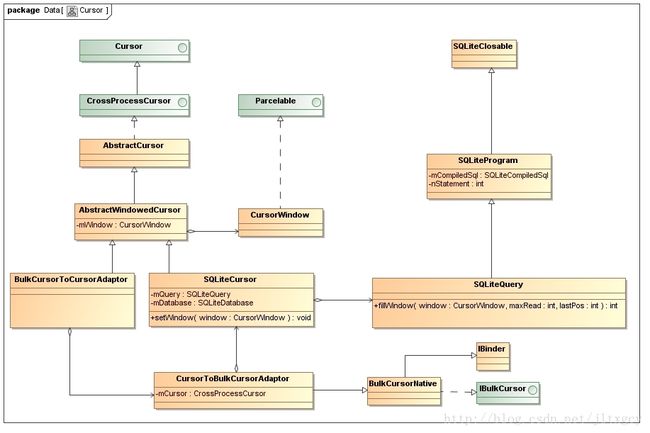Android Content Provider在应用程序之间共享数据的原理分析
本文参考Android应用程序组件Content Provider在应用程序之间共享数据的原理分析http://blog.csdn.net/luoshengyang/article/details/6967204和《Android系统源代码情景分析》,作者罗升阳。
0、总图流程图如下:
总体类图:
1、MainActivity进程向AriticlesProvider进程发送IContentProvider.QUERY_TRANSACTION
如图:第一步
~/Android/frameworks/base/core/java/android/content
----ContentProviderNative.java
final class ContentProviderProxy implements IContentProvider {
......
public Cursor query(Uri url, String[] projection, String selection,
String[] selectionArgs, String sortOrder) throws RemoteException {
//TODO make a pool of windows so we can reuse memory dealers
CursorWindow window = new CursorWindow(false /* window will be used remotely */);
BulkCursorToCursorAdaptor adaptor = new BulkCursorToCursorAdaptor();
IBulkCursor bulkCursor = bulkQueryInternal(
url, projection, selection, selectionArgs, sortOrder,
adaptor.getObserver(), window,
adaptor);
if (bulkCursor == null) {
return null;
}
return adaptor;
}
...... (2)创建类BulkCursorToCursorAdaptor对象。
(3)调用bulkQueryInternal。
~/Android/frameworks/base/core/java/android/content
----ContentProviderNative.java
final class ContentProviderProxy implements IContentProvider
{
......
private IBulkCursor bulkQueryInternal(
Uri url, String[] projection,
String selection, String[] selectionArgs, String sortOrder,
IContentObserver observer, CursorWindow window,
BulkCursorToCursorAdaptor adaptor) throws RemoteException {
Parcel data = Parcel.obtain();
Parcel reply = Parcel.obtain();
data.writeInterfaceToken(IContentProvider.descriptor);
url.writeToParcel(data, 0);
int length = 0;
if (projection != null) {
length = projection.length;
}
data.writeInt(length);
for (int i = 0; i < length; i++) {
data.writeString(projection[i]);
}
data.writeString(selection);
if (selectionArgs != null) {
length = selectionArgs.length;
} else {
length = 0;
}
data.writeInt(length);
for (int i = 0; i < length; i++) {
data.writeString(selectionArgs[i]);
}
data.writeString(sortOrder);
data.writeStrongBinder(observer.asBinder());
window.writeToParcel(data, 0);
// Flag for whether or not we want the number of rows in the
// cursor and the position of the "_id" column index (or -1 if
// non-existent). Only to be returned if binder != null.
final boolean wantsCursorMetadata = (adaptor != null);
data.writeInt(wantsCursorMetadata ? 1 : 0);
mRemote.transact(IContentProvider.QUERY_TRANSACTION, data, reply, 0);
DatabaseUtils.readExceptionFromParcel(reply);
IBulkCursor bulkCursor = null;
IBinder bulkCursorBinder = reply.readStrongBinder();
if (bulkCursorBinder != null) {
bulkCursor = BulkCursorNative.asInterface(bulkCursorBinder);
if (wantsCursorMetadata) {
int rowCount = reply.readInt();
int idColumnPosition = reply.readInt();
if (bulkCursor != null) {
adaptor.set(bulkCursor, rowCount, idColumnPosition);
}
}
}
data.recycle();
reply.recycle();
return bulkCursor;
}
......
} 如图:第二步,省略binder_transaction传输过程,因为上面已经分析过了。
如图:第三步
~/Android/frameworks/base/core/java/android/content
----ContentProviderNative.java
abstract public class ContentProviderNative extends Binder implements IContentProvider {
......
@Override
public boolean onTransact(int code, Parcel data, Parcel reply, int flags)
throws RemoteException {
try {
switch (code) {
case QUERY_TRANSACTION:
{
data.enforceInterface(IContentProvider.descriptor);
Uri url = Uri.CREATOR.createFromParcel(data);
// String[] projection
int num = data.readInt();
String[] projection = null;
if (num > 0) {
projection = new String[num];
for (int i = 0; i < num; i++) {
projection[i] = data.readString();
}
}
// String selection, String[] selectionArgs...
String selection = data.readString();
num = data.readInt();
String[] selectionArgs = null;
if (num > 0) {
selectionArgs = new String[num];
for (int i = 0; i < num; i++) {
selectionArgs[i] = data.readString();
}
}
String sortOrder = data.readString();
IContentObserver observer = IContentObserver.Stub.
asInterface(data.readStrongBinder());
CursorWindow window = CursorWindow.CREATOR.createFromParcel(data);
// Flag for whether caller wants the number of
// rows in the cursor and the position of the
// "_id" column index (or -1 if non-existent)
// Only to be returned if binder != null.
boolean wantsCursorMetadata = data.readInt() != 0;
IBulkCursor bulkCursor = bulkQuery(url, projection, selection,
selectionArgs, sortOrder, observer, window);
reply.writeNoException();
if (bulkCursor != null) {
reply.writeStrongBinder(bulkCursor.asBinder());
if (wantsCursorMetadata) {
reply.writeInt(bulkCursor.count());
reply.writeInt(BulkCursorToCursorAdaptor.findRowIdColumnIndex(
bulkCursor.getColumnNames()));
}
} else {
reply.writeStrongBinder(null);
}
return true;
}
......
}
} catch (Exception e) {
DatabaseUtils.writeExceptionToParcel(reply, e);
return true;
}
return super.onTransact(code, data, reply, flags);
}
......
} 如图:第四步
~/Android/frameworks/base/core/java/android/content
----ContentProvider.java
public abstract class ContentProvider implements ComponentCallbacks {
......
class Transport extends ContentProviderNative {
......
public IBulkCursor bulkQuery(Uri uri, String[] projection,
String selection, String[] selectionArgs, String sortOrder,
IContentObserver observer, CursorWindow window) {
......
Cursor cursor = ContentProvider.this.query(uri, projection,
selection, selectionArgs, sortOrder);
......
return new CursorToBulkCursorAdaptor(cursor, observer,
ContentProvider.this.getClass().getName(),
hasWritePermission(uri), window);
}
......
}
......
}(1)调用AriticlesProvider的query方法,获取了SQLiteCursor对象。
(2)由cursor和window对象,形成CursorToBulkCursorAdaptor对象。
如图,第五步
if (bulkCursor != null) {
reply.writeStrongBinder(bulkCursor.asBinder());
if (wantsCursorMetadata) {
reply.writeInt(bulkCursor.count());
reply.writeInt(BulkCursorToCursorAdaptor.findRowIdColumnIndex(
bulkCursor.getColumnNames()));
}
}
如图:第六步,省略binder_transaction传输过程,因为上面已经分析过了。
如图:第七步
~/Android/frameworks/base/core/java/android/content
----ContentProviderNative.java
IBulkCursor bulkCursor = null;
IBinder bulkCursorBinder = reply.readStrongBinder();
if (bulkCursorBinder != null) {
bulkCursor = BulkCursorNative.asInterface(bulkCursorBinder);
if (wantsCursorMetadata) {
int rowCount = reply.readInt();
int idColumnPosition = reply.readInt();
if (bulkCursor != null) {
adaptor.set(bulkCursor, rowCount, idColumnPosition);
}
}
}
adaptor.set(bulkCursor, rowCount, idColumnPosition);如图:第八步
return new CursorWrapperInner(qCursor, provider);
至此,我们形成了下图:

进程间通信结束了,下面我们分析如何应用匿名共享内存来传输数据。
在前面的一篇文章Android Content Provider的启动过程源代码分析http://blog.csdn.net/jltxgcy/article/details/37725749,最后获取了ContentProviderProxy对象,通过进程间通信来传递数据。
public class ArticlesAdapter {
......
private ContentResolver resolver = null;
public ArticlesAdapter(Context context) {
resolver = context.getContentResolver();
}
......
public Article getArticleByPos(int pos) {
Uri uri = ContentUris.withAppendedId(Articles.CONTENT_POS_URI, pos);
String[] projection = new String[] {
Articles.ID,
Articles.TITLE,
Articles.ABSTRACT,
Articles.URL
};
Cursor cursor = resolver.query(uri, projection, null, null, Articles.DEFAULT_SORT_ORDER);
if (!cursor.moveToFirst()) {
return null;
}
int id = cursor.getInt(0);
String title = cursor.getString(1);
String abs = cursor.getString(2);
String url = cursor.getString(3);
return new Article(id, title, abs, url);
}
}我们不分析详细过程,首先BulkCursorToCursorAdaptor对象里面的成员变量mBulkCursor通过进程间通信的方式,找到CursorToBulkCursorAdaptor对象,通过里面的成员函数mCursor查询出数据,并且保存在mWindows所指向的匿名共享内存。
而BulkCursorToCursorAdaptor通过成员变量mWindow来访问相同的匿名共享内存的。这样MainActivity就获取了数据。
如果是删除数据,可能不需要读写匿名共享内存,只要通过mBulkCursor通过进程间通信的方式的操作和读取返回结果。


